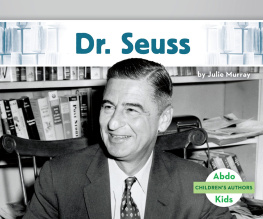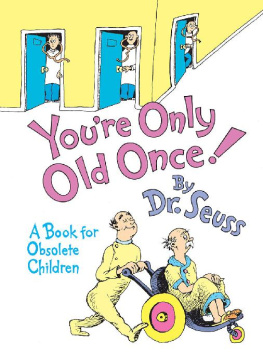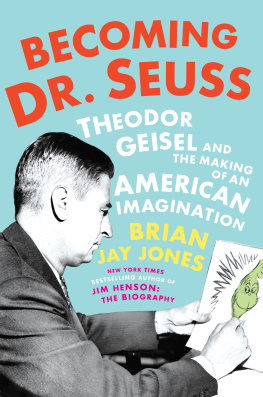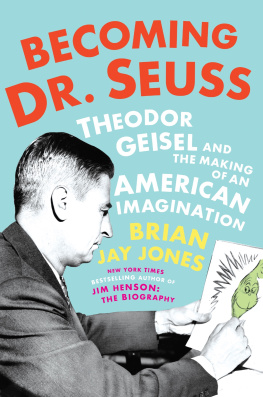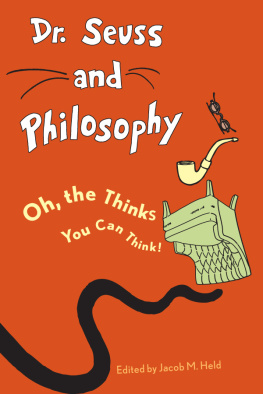Dr. Seuss Goes to War
ALSO BY RICHARD H. MINEAR
Victors Justice: The Tokyo War Crimes Trial
Hiroshima: Three Witnesses (editor and translator)
Through Japanese Eyes (editor)
Japanese Tradition and Western Law: Emperor, State, and Law in the Thought of Hozumi Yatsuka
Requiem for Battleship Yamato (editor and translator)
Black Eggs: Poems by Kurihara Sadako (editor and translator)
When We Say Hiroshima (editor and translator)

Dr. Seuss Goes to War
The World War II Editorial Cartoons of Theodor Seuss Geisel
RICHARD H. MINEAR
Published in cooperation with the Dr. Seuss Collection
at the University of California, San Diego

Text and compilation 1999 by Richard H. Minear. All rights reserved.
No part of this book may be reproduced, in any form,
without written permission from the publisher.
For permission to reprint portions of Ralph Ingersolls papers,
the publisher thanks The Ralph Ingersoll Papers, Special Collections, Boston University.
Published in the United States by The New Press, New York, 1999
Paperback edition, 2001
Distributed by Perseus Distribution
The New Press was established in 1990 as a not-for-profit alternative to the large, commercial publishing houses currently dominating the book publishing industry. The New Press operates in the public interest rather than for private gain, and is committed to publishing, in innovative ways, works of educational, cultural, and community value that are often deemed insufficiently profitable.
www.thenewpress.com
Book design by BAD
ISBN 978-1-5658-4704-0
8 10 9
Contents
What? Dr. Seuss, beloved purveyor of genial rhyming nonsense for beginning readers, stuff about cats in hats and foxes in socks, started as a feisty political cartoonist who exhorted America to do battle with Hitler? Yeah, right! And Ad Reinhardtthe guy who painted austere black-on-black abstractionsused to draw comic strips explaining modern art to the uninitiated! Both these unlikely phenomena in fact did occur in the pages of what may well have been Americas most remarkable daily newspaper, New Yorks PM. This short-lived popular front tabloid eschewed all paid advertising, though it did print announcements of department store bargains as news items. (It also first published Barnaby, a once-revered intellectual comic strip by Crockett Johnson, who later created the Harold and the Purple Crayon kid books.)
In some happier alternate universe, PM is still being published daily and Dr. Seuss was awarded a Pulitzer Prize for his anti-Fascist PM cartoons of 1941 and 1942. Actually, Dr. Seuss did get a Pulitzer in the universe we inhabit: a special citation in 1984 for his contribution over nearly half a century to the education and enjoyment of Americas children and their parents. Presumably, though, most of that award committee was as unaware of the heretofore lost cartoons in this volume as the rest of us. While its true that most of these cartoons lack the weight and gravitas of the cartoons by Herblock that did get the Pulitzer in 1942, they are still very impressive evidence of cartooning as an art of persuasion.
These cartoons rail against isolationism, racism, and anti-Semitism with a conviction and fervor lacking in most other American editorial pages of the period. These are virtually the only editorial cartoons outside the communist and black press that decried the militarys Jim Crow policies and Charles Lindberghs anti-Semitism. Dr. Seuss said that he had no great causes or interest in social issues until Hitler, and explained that PM was against people who pushed other people around. I liked that. More of a humanist than an ideologue one of those Groucho rather than Karl Marxists Dr. Seuss made these drawings with the fire of honest indignation and anger that fuels all real political art. If they have a flaw, its an absolutely endearing one: theyre funny.
Many of the editorial cartoonists of the time used grease crayon for their effects, evidence of their roots in the Honor Daumier tradition. Dr. Seusss twisted roots, on the other hand, were in the vaudeville tradition of early comic strips and gag cartoons. Theodor Geisel (Dr. Seusss real name) began his career in the late 1920s, doing gag cartoons for the two most important humor magazines of the time, Judge and Life. He received his first renown for a long-lived series of cartoons advertising a bug spray called Flit. (One of the more memorable images reprinted in this volume has Seusss Uncle Sam eagle about to shoot a Flit spray gun labeled U.S. Defense Bonds and Stamps at enormous Adolf, Tojo, and Benito bugs.) In 1935, he briefly turned out a comic strip for King Features called Hejji. And he produced four well-received childrens books before hooking up with PM, though his grand-scale success as a childrens book artist didnt come until the late 1950s. But the idioms of the picture book, the comics, gag cartoons, and advertising informed his PM work. Over the past twenty to thirty years the newspaper editorial cartoon has reduced its ambition, basically becoming a gag cartoon with political subject matter. Dr. Seusss political cartoons were, perhaps, ahead of their time in seeking to entertain as well as convince. This is by no means to deny Seusss earnestness, its just that much as with Chaplins The Great Dictator comedy was too frail a weapon to deal mortal blows to Hitler. (On the other hand, its also true that the far more vitriolic cartoons of George Grosz and John Heartfield were no more adequate to the task.)
One of the great pleasures in this collection of drawings (beyond the not inconsiderable one of getting a painless history lesson on the side) is the affirmation of just how good the good Doctor really was: good at communicating his ideas clearly and just plain old-fashioned good. He called em as he saw em, and most of the time he was on the side of the angels. The greatest pleasure, though, lies in watching the artist develop his goofily surreal vision while he delivers the ethical goods. The unique galumphing menagerie of Seussian fauna, the screwball humor and themes that later enraptured millions (as well as earning millions of dollars for the artist), come into focus in these early drawings that were done with urgency on very short deadlines.
The PM cartoons make us more aware of the political messages often embedded within the sugar pill of Dr. Seusss signature zaniness. For better or worse, the didactic moralist struggled for supremacy over the iconoclastic jokester in much of his mature could that be the right adjective? work. Yertle the Turtle (visually prefigured in a stack of turtles forming a victory V in a March 20, 1942, cartoon) is an anti-fascist tract. The Sneetches is clearly a plea for racial tolerance (what are those stars on thar bellies, if not Magen Davids?). An environmental message overwhelms any of the nonsense in The Lorax, and the polemic for nuclear disarmament in The Butter Battle Book created a blizzard of controversy when it first appeared in 1984.
The Cat in the Hats red-and-white-striped leaning tower of a stove-pipe has become an American icon only slightly less recognizable than the Disney mouse ears. Seeing the slightly battered lid on the Seuss bird that represents the United States in many of the PM drawings (presumably its an eagle, though it looks as much like a Sneetch and suspiciously like the prominently beaked Theodor Geisel himself) is disorienting enough to bring on an epiphany: the prototype for the cats famous headgear is actually an emblem deployed in countless political cartoons: Uncle Sams red-and-white-striped top hat! The Cat in the Hat is America!


